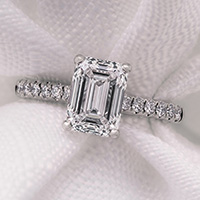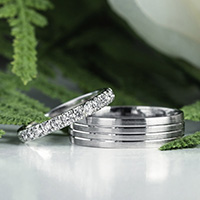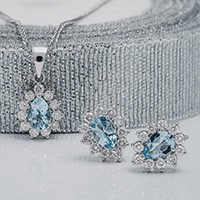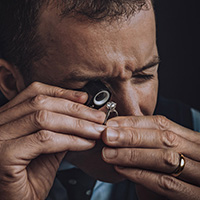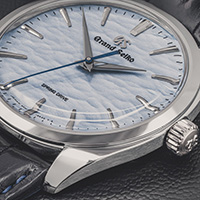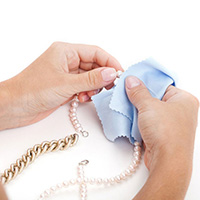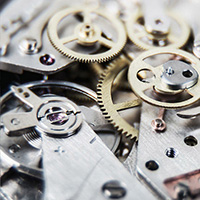- Home/
- Types of Diamond Cut | Most Popular Diamond Shapes | James Porter
Diamond Shape Guide
In this guide
What is diamond shape?
Diamond ‘shape’ is often mistaken for diamond ‘cut’ which actually refers to how well a diamond’s proportions are finished, diamond shape refers to the outline and form of a diamond after it has been cut & polished. Shape is one of the more important factors to consider when choosing a diamond ring because each shape has pros and cons to the overall look and cost of a piece of jewellery.
When most people think of a diamond, they think of a classic ‘round’ shaped diamond because ‘round’ diamonds are the oldest, most traditional and by far the most popular sold throughout the world. Although ‘round’ diamonds appear to be a favourite, there are a lot of other diamond shapes available on the market. Some have round edges, some have straight or sharp edges, some are favoured for their geometric shape while others are favoured for their ability to refract light and produce more sparkle.
Most Popular Diamond Shapes
It can be tricky finding the perfect engagement ring, there are a ton of reasons why some people prefer some shapes over others. Rather than list all the diamond shapes known to man, we’ve detailed below the top 10 most popular shapes that make up the majority of the diamond market today.
To help with your quest for the perfect shape, we’ve also listed pros and cons for each cut based on our years of experience selling these shapes. Before you look at the shapes, it's important to understand 'brilliance' and 'sparkle'. Both are used when describing diamond shape and although they sound like the same thing, they are slightly different:
What is brilliance?

Brilliance is the amount of colourless light that is reflected from a diamond. The overall brilliance of a diamond is determined by the quality of the cut and shape. For example some cuts and shapes make a diamond seem duller and therefore less brilliant.
What is sparkle?

The sparkle of a diamond aka its ‘scintillation’ refers to the dancing of light from between the inner walls of a diamond towards the center of the diamond. For example, when a diamond is moving you can exhibit a little or a lot of sparkle. Sparkle is also determined by shape and cut.
Emerald Cut
An emerald cut diamond is a sophisticated shape born out of the 1920’s. It is admired for it’s transparency and depth rather than it’s brilliance. Looking down into the top of a diamond is like looking into a hall of mirrors as you can see all the way in. Sparkle can be seen from the edges of this cut.
- Pros: Emerald shaped diamonds are one of the cheapest of all the shapes which can leave you with some budget to spend on higher colour or clarity grades to make the ‘hall of mirrors’ even more stunning
- Cons: Because of its depth, translucency and large table (top), imperfections are easily spotted by a keen eye. The best way to make sure this shape works for you is to go and see it in person
- Cost: Low
- Ideal for: Fans of vintage and art deco
Heart Cut
Increasingly popular and very cute, the heart shape is for true romantics. The heart diamond is derived from the pear shape and requires a highly skilled diamond cutter to make sure the heart ‘lobes’ are perfect. We recommend a heart that is at least 0.5 carats or higher to get the best out of the shape.
- Pros: The biggest pro is of course that it’s a love heart! This means it has a lot of applications, valentine’s day, sorted, engagement, no problem, romantic sentiment, easy!
- Cons: It can be tricky to buy this shape to get a clear outline and symmetrical ‘lobes’. Often they are cut to maximise their size rather than their radiance and beauty. Keep a sharper eye open for grading of heart diamonds
- Cost: Low/medium
- Ideal for: Sentimental romantic types
Marquise Cut
Famed for its standout shape, this diamond is long and pointed at each end making it one of the rarer cuts to get your hands on. It’s definitely not for everyone and can’t boast the same popularity as round cuts but it’s shape looks excellent on a ring finger.
- Pros: A flattering effect, slimming the ring finger. The shape also looks much larger when compared to other shapes of the same carat weight due to it's long surface area making it appear more expensive than it is
- Cons: The sharp tips at each end are susceptible to chipping if not protected by the best setting. The narrow shape at each end can also cause a loss of colour in the center so choosing a well-cut marquise is recommended
- Cost: Medium
- Ideal for: Those that love to grab attention
Princess Cut
Princess cut diamonds are still considered a stylish and contemporary cut created in the 1960’s. It is a delicate and feminine shape which became famous for its ability to produce beautiful brilliance which rivals the traditional round shaped diamond in popularity.
- Pros: Similar to round cuts, princess cuts produce so much brilliance that they can often hide a multitude of flaws in a diamond, meaning they almost always look great however big or small!
- Cons: The sharp corners of a princess cut can chip or snag on clothing, bear this in mind if your significant other does a lot with their hands
- Cost: High
- Ideal for: The fashion conscious
Asscher Cut
Asscher cuts are a modern vintage shape from around the art deco era. Asscher is one of the most popular square cuts. Like the emerald cut, square cuts also create the beautiful ‘hall of mirrors’ illusion.
- Pros: It has the same appeal and depth as the emerald cut diamond but with more neatness, brilliance and sparkle
- Cons: It has a small surface area when compared to other shapes and, like the emerald cut, it is easier to spot some flaws in this shape
- Cost: Medium/high
- Ideal for: Those who enjoy a vintage look but still want the sparkle
Round Cut
Round cut diamonds are shaped the way they are to allow for maximum refraction and reflection of light and sparkle. They are by far the most researched diamond shape going back to the 1700’s. They are a timeless classic and are found in half of all engagement rings, you can’t go wrong.
- Pros: The shapes intense brilliance and sparkle can hide a multitude of flaws which, despite it’s price tag, can help you get the best for a good price
- Cons: On average, round diamonds do cost 30-40% more than other diamond shapes because the most raw material is lost in the process of shaping them, keep that in mind when you go and see one
- Cost:High
- Ideal for: Those with classic traditional taste but round is a true all-rounder for style
Cushion Cut
The cushion or ‘pillow’ cut diamond has become arguably the third most popular cut after the round and princess. It’s rounded corners, curved edges and square shape give a unique style and depth.
- Pros: The cushion cut has gone through many transformations since the 1900’s to help maximise it’s light dispersion despite its softer more romantic shape
- Cons: This cut isn’t renowned for its brilliance as they can often be cut poorly due to the round edges
- Cost:Medium
- Ideal for: Those with traditional tastes but what something a little different
Pear Cut
The pear or ‘teardrop’ cut is a unique and hybrid combining the brilliance and design style of both the round and marquise that results in a shape with a single point and rounded end to create a truly elegant shape.
- Pros: Much like the marquise, the pear cut has a slimming effect on the ring finger, especially when warn with the pointed end towards the finger nail
- Cons: Like oval shaped diamonds, pear cuts can suffer from darkness in the centre. It can also appear yellow in places as the diamond tapers. This is another diamond that you need to see in person before you buy
- Cost:Low
- Ideal for: Those who are considered glamorous by nature
Radiant Cut
The first radiant cut diamond was made in 1977 with its distinctive trimmed edges and square/rectangular top. Radiant combines the brilliance and depth of the round, emerald and princess cuts making it a popular choice as an all-rounder for all types of jewellery.
- Pros: Radiant, as its name suggests is all about sparkle. If you like the style of square or emerald but don’t want to compromise on the flash, radiant cut diamonds are an ideal choice - it's often described as 'similar the princess without sharp corners'
- Cons: More expensive than princess cuts of the same carat because of the loss of more raw material. Having said this it’s a better choice if sharp corners are unsuitable
- Cost:High
- Ideal for: The fashion conscious who work with their hands
Oval Cut
The oval shape is a modern classic born out of the 1960’s. The shape maximises it’s carat weight meaning it can appear larger than round stones of a similar carat. It’s a simple shape that is unique enough to stand out without being over the top.
- Pros: Oval cuts are great way to elongate shorter fingers, the cut is also considered a ‘modified round’ cut so it also has similar brilliance and sparkle
- Cons: Can exhibit some darkness in the center of the stone. Another stone that needs to be seen in person. Make sure the setting compliments the effect in the center of the stone
- Cost:Low/mediumh
- Ideal for: Those that express their individuality but appreciate traditional style
Which is the best cut/shape?
As you can see, the ‘best’ diamond shape is entirely dependant on the taste of your recipient. Whether it’s contemporary clean and sharp edges like the princess or deep crystal-like translucence of cuts like emerald and square. To help, we’ve rounded up our personal top three best diamond shapes for best value, best sparkle, biggest and most expensive/show stopping:
Best diamond shapes for value

The cushion, square & heart shaped cuts are by far the best value for money, they don’t reveal too many flaws and they don’t lose much raw material to be created while still being beautiful stones to gift a loved one
Best diamond shapes for sparkle

Due to its hundreds of years of research, the round cut exhibits the most brilliance and most sparkle. It hides its flaws well and is the most shiney overall. It is closely followed by the pear and marquise cut with their excellent sparkle
Best diamond shapes for size

Elongated diamonds look the largest due to their large surface area which maximised the carat weight when compared to other cuts such as round cuts. The top three are emerald, pear and marquise but the oval is also a strong contender for this category
Best diamond shapes overall

Due to the amount of raw diamond lost in the cutting process, the round cut is the most expensive with radiant and princess coming in a close second and third. Bear in mind that sparkle is counteracted if you go for a stone of lower clarity
Expert Buying Tip:
Keep your eyes peeled for diamonds that are just under popular carat weights such as 0.5 carat, 1 carat or 0.75 carat. Weights slightly under these popular weights often get sold at a discounted rate compared to those at full weight. For example a .40 carat or .90 carat diamond will cost less on a ‘per carat’ basis than a full 1 carat diamond and visually be almost identical.
Overwhelmed? Here’s what to remember:
- Round cuts give off the most brilliance and will sparkle the most - this hides flaws and give you more leeway with cost for colour and clarity
- Round are the most expensive and emerald are the least expensive
- ‘Step cuts’ like square, emerald, asscher are not know for brilliance or sparkle and shine in a different way - choose higher clarity and colour grades with these cuts
- Fancy cuts like oval, pear, marquise can have dark patches in the centre of the stone - go and look at them in person and speak to an expert before snapping one up
- Take your time and match the shape and style to the recipient’s tastes, style and what they do with their hands - they will want to wear it all the time
Have A Question?
Contact us by phone at 0141 221 5855 or by email at [email protected]. We love our work and will be happy to help you with your query, we can also book a convenient time for a consultation to find the exactly what you need..
 Back to top
Back to top
 Basket
Basket


























 0141 221 5855
0141 221 5855 Send us an email
Send us an email
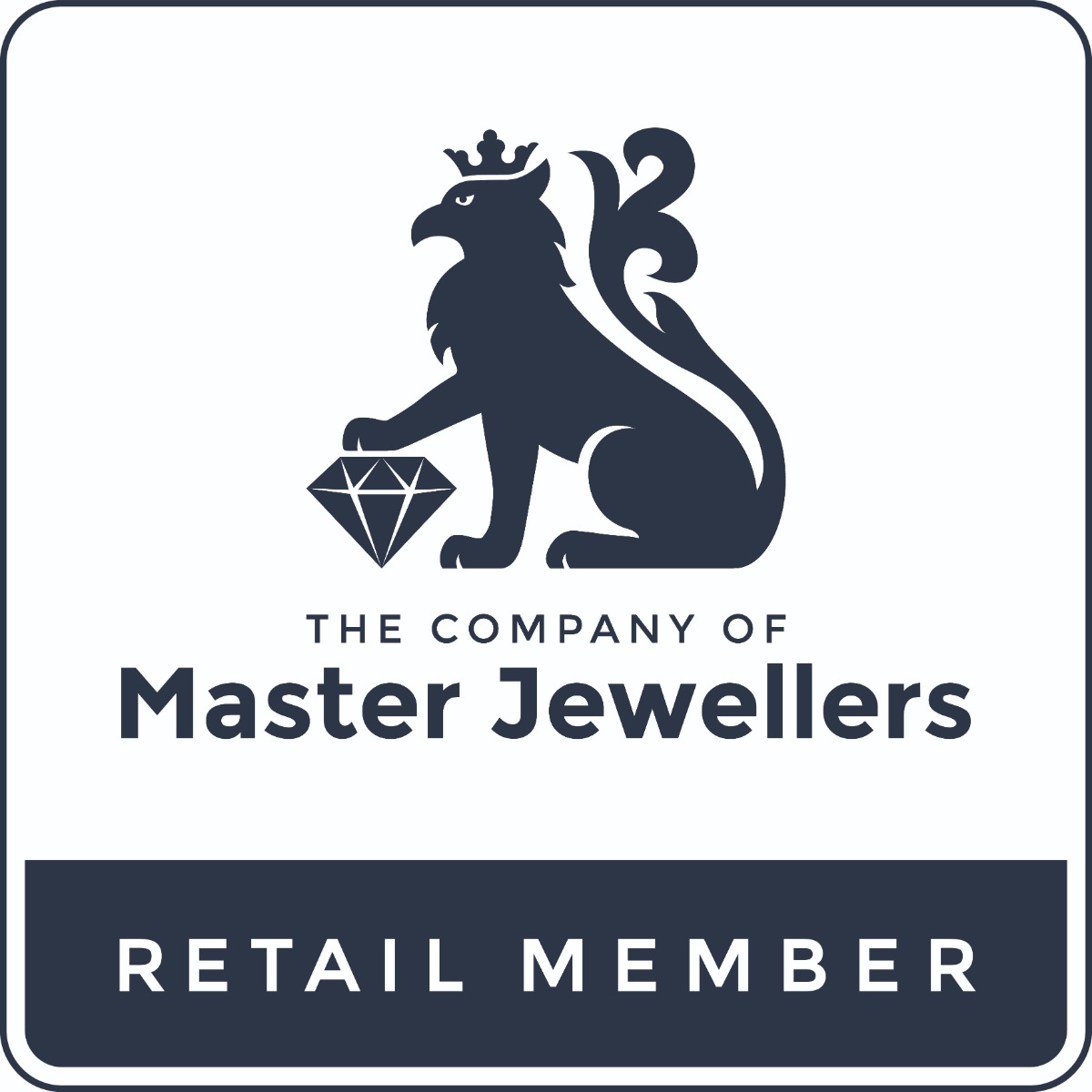





 Secure payment methods
Secure payment methods


